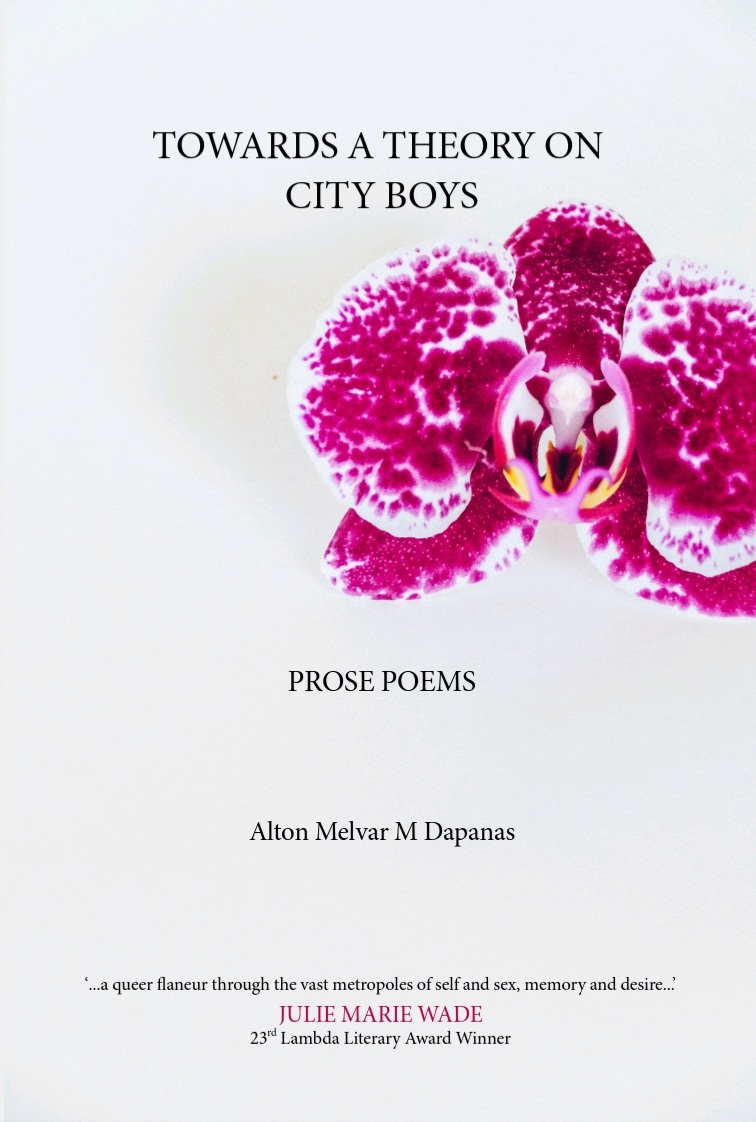Published April 24th, 2023
Review
by Sofija Popovska
When Jorge Luis Borges wrote The Book of Sand, it was an act of accidental clairvoyance. A real-world manifestation of this endless tome would hit the shelves almost half a century later: in 2021, Newcomer Press published Towards a Theory on City Boys, a prose-poetry collection by Alton Melvar M Dapanas (they/them), a poet, translator, and essayist from the Philippines. Contained in this slim volume are play with genres and formats, portraits of loves and wounds — both fresh and new, ecologies of queer spaces popular and liminal, landscapes of the city, of bodies of water, of mountains and beaches… Most importantly, however, this collection presents a mutable portrait of its lyrical narrator (a composite title to fit the composite genre), a snapshot of a subject-in-motion, engaged in negotiations with the external, which is absorbed into and expelled from the intimate as the subject moves through time and space.
***
An initial standout feature of the book is the playful hybridity of the collection’s format, which extends well beyond the prose-poetry genre. For example, the first part, A Catalogue of City Boys with Common Names, sees the paratext take the place of the main body of text: a few past lovers are presented as footnotes under pages containing nothing save for a name and location. This choice already situates the work in the realm of heterogeneity and play, but it also shows the group of amants their place: the lyrical voice is at the center of the text — is the text itself, in fact — whereas they are footnotes to repetitive names and well-worn locations. Thus, the reader’s first encounter with an unusual application of format is transformed from a delight in originality to a vicarious disambiguation of boundaries, the thrill of freedom afforded by poetry’s ability to re-mold the world. Dapanas goes on to make rich use of a variety of genres: geographies, histories, etymologies, poetic portraits, all of which serve to enrich the multifaceted subject-in-motion and take the reader through unforgettable locales.

The collection opens with the lyrical narrator in Macajalar Bay, the interstice between a “city of excess” and the “immense expanse” of the Bohol Sea. Bordered by two of the major forces in the prose-poems to come—the city and water—this space harbors both spectral presence and a premonition of absence, setting us up to experience a peregrination abundant with euphoria, self-pity, discovery, and loss. Next we move through the narrator’s home: a “sun-rinsed island town,” through beaches and city streets, abandoned corners and local restaurants, through Dry and Rainy Season, through portraits of others and the self, until we arrive, at last, at a new beginning. Subversive from start to finish, Towards a Theory on City Boys refuses a recognizable end; instead of rolling the credits, it leads us to the same landscape, albeit in a different location: between the sea and the mainland, the lyrical narrator introduces an ultimatum of rebirth: “You can never go home again.” After all, a seaport is always both a point of return and of departure.
Towards a Theory on City Boys is constructed with a holism of its guiding principle that permeates the entire structure on all of its levels and reveals itself in a hypnotic progression, much like moving images of the Mandelbrot set. In this case, the guiding principle can be summarized as hybridity, versatility, and movement. What makes this collection especially delightful, however, is that its fluid, transform/-ing/-ative content enacts its lyrical maneuvers with a ludic, at times humorous, ease. To illustrate this, the collection opens with an artful takedown of an “old poet” featured pseudonymously (perhaps for the preservation of whatever honor might remain after the verbal annihilation with the innocuous title Preface: Some Notes On The Prose Poem) as Madam M. Following an etymological exploration of the prose poem concept, Dapanas delivers a preemptive strike to the critics of prose poetry, with Madam M bearing the brunt of their articulate venom. After being nicknamed “a remnant of the veiled theatrics of a prescriptive cultism”, Madam M is likely to refrain from mobilizing her “paleoconservative pedagogy” to disparage young poets’ literary breakthroughs – I know I would. The final touch—or final blow, if you will—is how Dapanas introduces a bibliography on the genre: “Madam M could read…”
A key aspect of the work that is all but monolingual is the narrator’s voice itself. Infused with words from Spanish, Cebuano Binisaya (the author’s mother tongue), Northern Mindanao Binisaya, mythological terms from pre-Hispanic lore, among others, the narrator’s English reflects the complexity of their subject matter. Moreover, this way of writing feels deeply personal and personalized; just as Dapanas re-molds the world as they narrate it, they re-mold English to mirror personal identity — an entanglement of the intimate and the collective, a node where cultures, languages, and ontologies intersect—especially rich and multifarious in a location like the Philippines. Language, like the seaport, presents a point for departure, from which the principle of variable intricacy extends throughout the construction and content of the work.
There is definitely something to be said about how the native hybridity of the prose-poetry genre finds its resonance in certain central thematic aspects of Dapanas’ text. A first, most vibrant equivalent is the fluid narrating voice, whose subjective boundaries shift to envelop objects outside its skin — “This house is your shirt, you own every crease and crevice of it” — or withdraw, to exclude parts of the self which no longer serve it — “You are asked to purge the parts you no longer need, to shed the skin you/have outgrown.” Visually, this osmotic process between the focalizing subject and their environment recalls maritime negotiations between the lapping waves and the shore; the prevalence of water imagery in this collection, thus, pertains to all its strata: setting, structure, theme, spirit. . . The water element as internally and externally present, formative, and communicative is already established paratextually before we encounter the introduction, through a quote by Eric Gamalinda: “Between you and memory/everything is water.” Water haunts and permeates the collection in its many iterations: storms, lagoons, rivers, the ocean. This liquidity is expressed not only in its shape, but also in the nature of its relationship to the lyrical voice: water as a “thunderous sea” of passion; water as sweat at the apex of lovemaking; water as a site of romance featuring two lovers reading Rimbaud; water as a site of violence and trauma.
-precy-jain-m.-dapanas.jpeg)
What appealed to me most about the changeability evoked by the water imagery (and realized on every level of Dapanas’ prose-poems) was the irreverence and aversion towards control implicit in it. Throughout the collection, the lyrical subject is pursued by claustrophobic restrictions characteristic of queer existence, especially in close-knit communities where privacy is an object of Sisyphean desire. The setting, “a country where everything is known and there are no secrets,” where even the sounds of rubber slippered-footsteps at midnight “call each inhabitant by their names,” certainly affords no secrecy — and other people, like the cousin who “campaigned for a bigoted, anti-LGBTQ+ boxer-senator” transform the landscape into a maze of barbs and betrayals. Against this backdrop — here, against takes on a multitude of meanings — the narrator remains emphatically themselves: lucid, lustful, amorous, at times self-destructive, at other times repentant, but at all times their tumultuous, ever-transforming self. Moments of humor strewn about the collection testify both to the narrator’s trenchant wit and their spiritual resilience: “How many graveyards for this boning?” made me laugh in simultaneous delight and disbelief, seeing as it followed after entries fraught with heavy feelings of yearning and isolation. Just as in the preface, humor emerges at the intersection of playfulness and courage, infused with a distinct umami flavor: somewhere between eliciting a delighted smile and drawing blood.
Discussing a work like this really does feel like looking at a GIF of fractal geometry: its peculiar, mutable enchantment extends indefinitely, and every re-reading reveals an aspect previously unseen. Unfortunately, unlike the joy I derived from this collection, the word limit for a book review is very much finite, and so I’ll wrap it up with an approximation of a final sentiment. Towards a Theory on City Boys provides us not only with an ecology of queer spaces (and interstices) of Dapanas’ hometown, a history of waters, and a cartography of love’s protean body, but also with an irreverent lyrical ontology opposed to all that is static, retrograde, and restrictive. A self-portrait of a subject-in-motion, its scale oscillates between the boundlessness of an ocean and the minutiae of a drop of water with equal ease — revealing the murky, obscuring the (seemingly) pellucid, severing the obsolete and absorbing alterity; finally, it presents a celebration of heterogeneity on the stylistic and thematic level, proving itself to be the hybrid artwork par excellence.
Nationality: North Macedonian
First Language(s): Macedonian
Second Language(s):
English
Supported by:


Comments on "Self-Portrait as a Subject-in-Motion: A Review of "Towards a Theory on City Boys: Prose Poems" by Alton Melvar M Dapanas"
Please log in to submit a comment.
Login